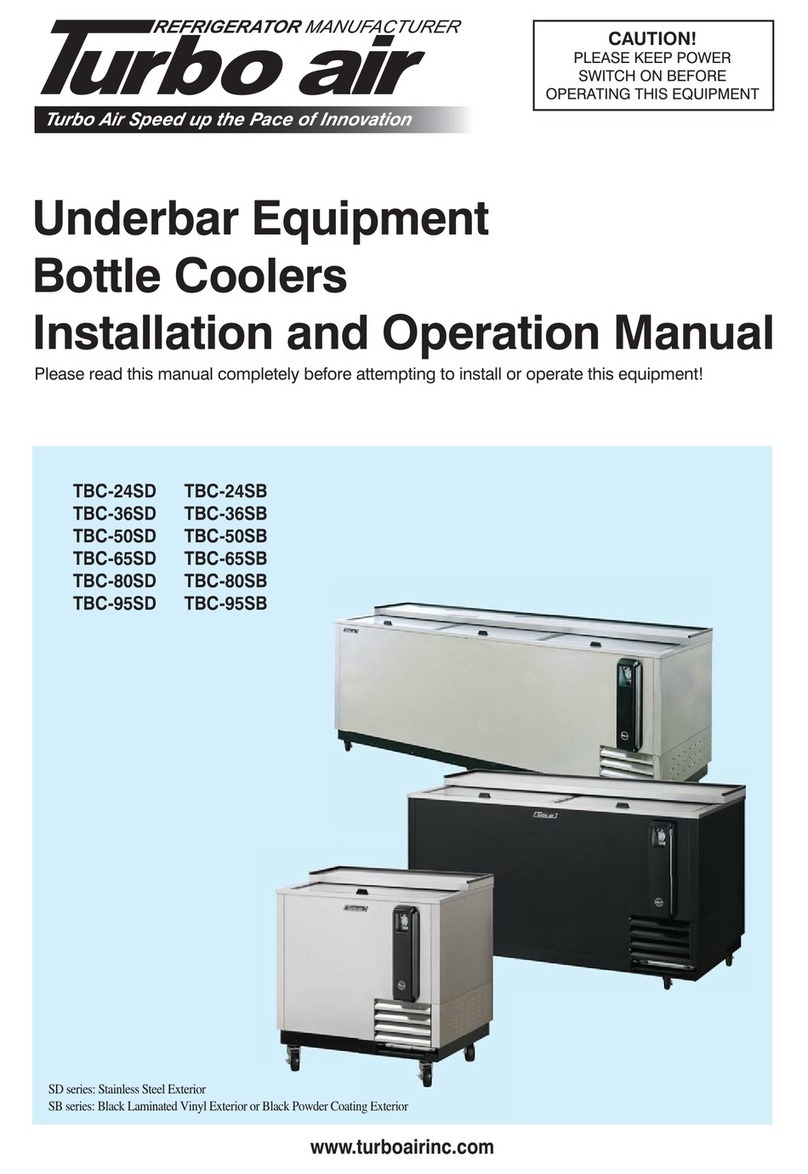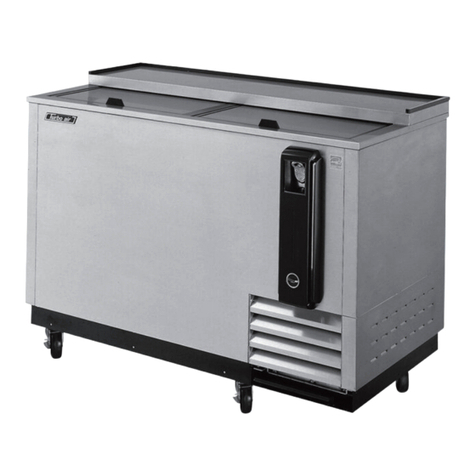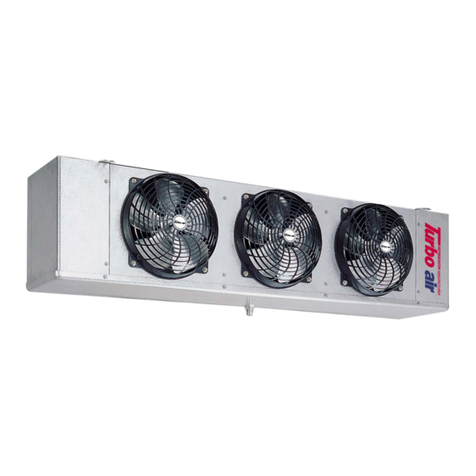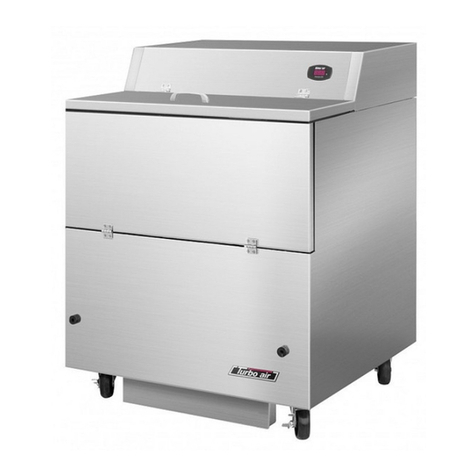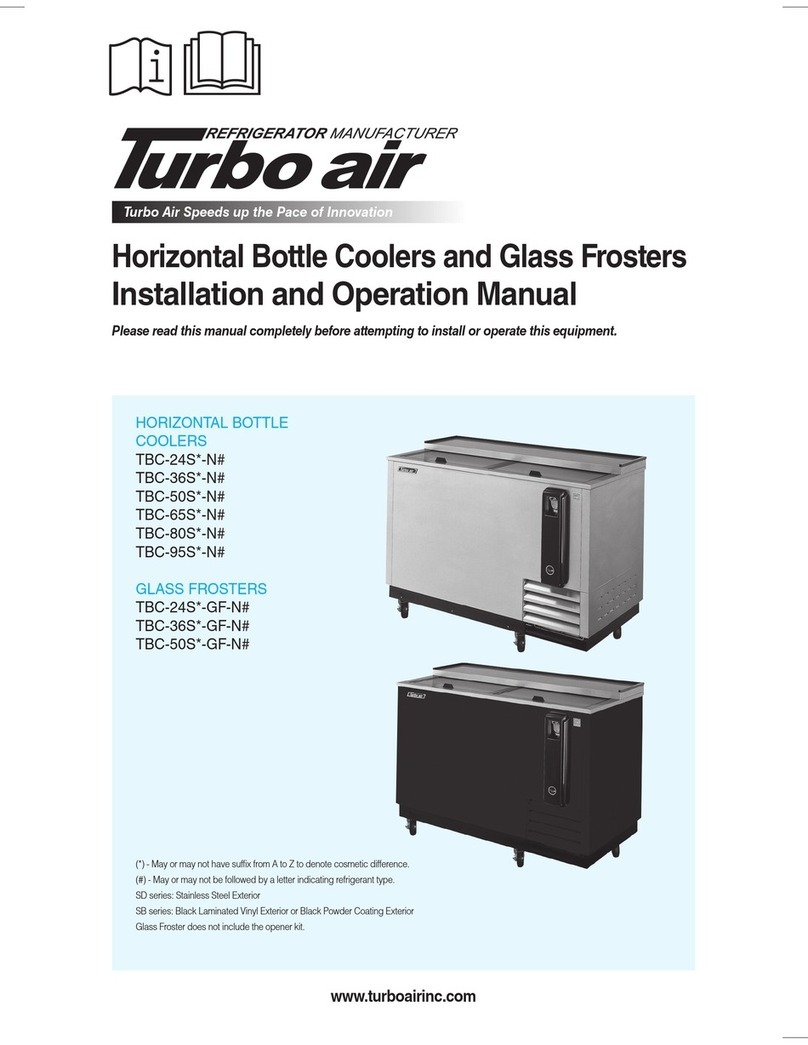
10
Turbo air
Model
Rating
Temp. (℉)
Operating
Temp. (℉)
Equipment Class
Designation
V/Hz Refrigerant AMPS
TBB-1SB-N# 38(M) ≥32 VCS, SC, M (110-120) V~, 60Hz R-600a / 1.59 oz (45 g) 1.3 A
TBB-2SB-N# 38(M) ≥32 VCS, SC, M (110-120) V~, 60Hz R-600a / 2.29 oz (65 g) 1.7 A
TBB-3SB-N# 38(M) ≥32 VCS, SC, M (110-120) V~, 60Hz R-600a / 2.29 oz (65 g) 1.9 A
TBB-4SB-N# 38(M) ≥32 VCS, SC, M (110-120) V~, 60Hz R-290 / 3.35 oz (95 g) 2.9 A
TBB-2SG-N# 38(M) ≥32 VCT, SC, M (110-120) V~, 60Hz R-290 / 3.70 oz (105 g) 2.8 A
TBB-3SG-N# 38(M) ≥32 VCT, SC, M (110-120) V~, 60Hz R-290 / 3.70 oz (105 g) 2.8 A
TBB-4SG-N# 38(M) ≥32 VCT, SC, M (110-120) V~, 60Hz R-290 / 4.23 oz (120 g) 3.3 A
TBB-24-48SB-N# 38(M) ≥32 VCS, SC, M (110-120) V~, 60Hz R-600a / 2.65 oz (75 g) 1.8 A
TBB-24-60SB-N# 38(M) ≥32 VCS, SC, M (110-120) V~, 60Hz R-600a / 2.65 oz (75 g) 2.0 A
TBB-24-72SB-N# 38(M) ≥32 VCS, SC, M (110-120) V~, 60Hz R-600a / 2.82 oz (80 g) 2.0 A
TBB-24-48SG-N# 38(M) ≥32 VCT, SC, M (110-120) V~, 60Hz R-290 / 3.00 oz (85 g) 2.6 A
TBB-24-60SG-N# 38(M) ≥32 VCT, SC, M (110-120) V~, 60Hz R-290 / 3.17 oz (90 g) 2.9 A
TBB-24-72SG-N# 38(M) ≥32 VCT, SC, M (110-120) V~, 60Hz R-290 / 3.17 oz (90 g) 2.9 A
TBD-1S*-N# 38(M) ≥32 VCS, SC, M (110-120) V~, 60Hz R-600a / 1.59 oz (45 g) 1.1 A
TBD-2S*-N# 38(M) ≥32 VCS, SC, M (110-120) V~, 60Hz R-600a / 2.82 oz (80 g) 1.9 A
TBD-3S*-N# 38(M) ≥32 VCS, SC, M (110-120) V~, 60Hz R-290 / 3.17 oz (90 g) 2.5 A
TBD-4S*-N# 38(M) ≥32 VCS, SC, M (110-120) V~, 60Hz R-290 / 3.53 oz (100 g) 2.7 A
TCB-2S*-N# 38(M) ≥32 VCS, SC, M (110-120) V~, 60Hz R-600a / 2.47 oz (70 g) 1.3 A
TCB-3S*-N# 38(M) ≥32 VCS, SC, M (110-120) V~, 60Hz R-600a / 2.47 oz (70 g) 2.3 A
TCB-4S*-N# 38(M) ≥32 VCS, SC, M (110-120) V~, 60Hz R-290 / 3.00 oz (85 g) 2.6 A
The serial number is located on the data label inside the cabinet.
Please retain the unit's serial number for service purpose.
VCT : VERTICAL CLOSED TRANSPARENT
VCS : VERTICAL CLOSED SOLID
HCT : HORIZONTAL CLOSED
TRANSPARENT
HCS : HORIZONTAL CLOSED SOLID
SC : SELF-CONTAINED
M : MEDIUM TEMPERATURE APPLICATION
L : LOW TEMPERATURE APPLICATION
SPECIFICATIONS
SERIAL NUMBER
TBB,TBD,TCB모델(영)_미주향.indd 10 2017-06-23 오전 10:25:46
